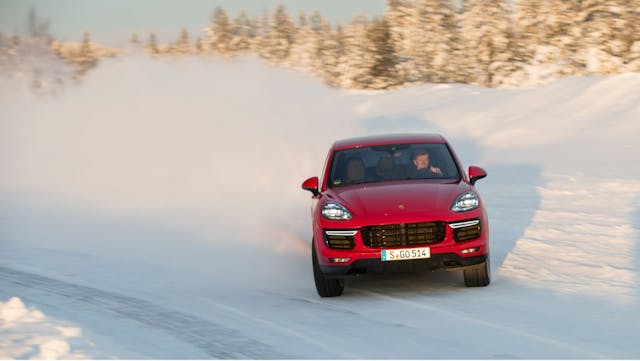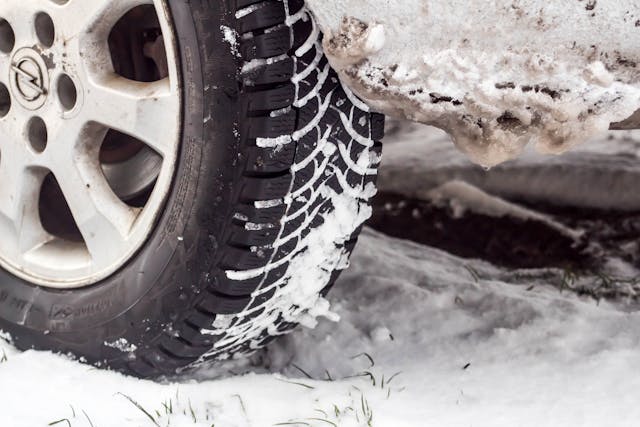5 reasons why winter tires matter, and not just for enthusiasts
As winter approaches, the prudent Canadians among us begin to think of our tire choices for the snow and ice that are to come. Some of us still believe that all-seasons are a four-season tire, but that couldn’t be further from the truth. Generally, this sort of rubber works perfectly well in the climates of several southern U.S. states, but enthusiasts like us understand the benefits of the correct tire for specific driving conditions.
If you live in a climate where white stuff falls from the sky—and even if you don’t consider yourself a gearhead—winter-specific rubber should be a no-brainer. Here are some reasons why.
Yes, even if you have all-wheel drive

Plenty of drivers believe that their all-wheel-drive crossover or their four-wheel-drive pickup offers superior traction without requiring winter tires. I’ll concede that you’ve got a little more traction with four driven wheels than with two, because you’re distributing torque to twice as many contact patches, but what happens when you have to brake?
Braking on snow and ice is a different beast altogether. I can cite countless tests and studies that unequivocally demonstrate the benefit of winter over all-season tires—better performance during braking, acceleration, and cornering. If you can now stop your winter tire-shod car a few feet shorter than with your summers, that’s the difference between stopping safely and suffering a wee crash.
I’ve even participated in some of the aforementioned tests and the traction that winter tires offer in snow, on ice, and in generally cold conditions is simply superior. Not only that, several instrumented tests also suggest that a winter tire has a shorter stopping distance than a summer tire in cold temperatures.
Built different

Performance tires use stiffer construction, a tread pattern designed for maximum dry grip with the ability to evacuate some water for wet traction, and a rubber compound intended to work best at higher temperatures. When you look at the tread of a winter tire, you’ll see a polar opposite approach: Large gaps between tread blocks for grip in snow and sipes (those squiggly lines in the tread blocks) that help evacuate even more water from under the tire.
If you’ve never run winters in the deep snow, the difference in traction and control is remarkable. You’ll be blown away by unnatural levels of grip in the powdery stuff. Plus, like a Mustang leaving a cars and coffee, I look forward to liberal hooning every Canadian winter—safely, of course—and there are few joys greater than sliding around in an empty parking that’s covered with a few inches of fresh snow.
I’ve got a sense of Ontario and Quebec’s winter weather, but to understand the western coast of North America, I called Tony Morris, Jr., an old racer friend of mine. Where he lives in Vancouver, winter weather doesn’t demand winter tires, but since he loves snowboarding perhaps more than I do, he travels to the mountains. All-season tires won’t cut it under those conditions—plus, there are some regions that require snow tires in British Columbia, so he also installs winters on his F-150. Great minds think alike.
The great slush threat

Winter weather varies from the it-never-snows-here-are-you-kidding-me spots on Vancouver Island to downright frigid northern Alberta, which demands a studded winter tire. With several distinct climates, producing a tire for Canadian winters is a real challenge. Plus, in Ontario and Quebec, we have that winter-road phenomenon known as slush. After driving in this grossness for decades, I’ve never found a winter tire that can competently handle the stuff.
If you’re not familiar with it, slush occurs when snowy roads have been aggressively salted, as they are in this part of the world. In addition to ruining the structure and body panels of vehicles, salt lowers the freezing point of water and there’s a sweet spot just above the salted snow’s new freezing point where it turns to the consistency of a sugar-laden snow cone. Every winter tire I’ve driven to date accumulates slush to some degree or another, thus compromising its traction. By the middle of each winter, I’m cursing slush as if it’s my worst enemy.
Bonus: A Continental for Canadians

Last February, I participated in a unique test of the Continental IceContact XTRM tire that’s designed exclusively for the Canadian market. Not only is it intended for the kinds of performance-oriented, European cars Canadians prefer, it’s also focused on the unique challenges of varied road conditions in the Great White North. The winter tires we see in Canada are copy-paste affairs from other markets, and in all of my years of driving I’d never heard about a tire designed for this little country.
This Continental is available in a broad range of passenger-car sizes from compact cars to sports cars to ultra-luxury SUVs, as well as in both studded and non-studded specifications, so almost all bases are covered. However, after speaking with David Giguère of Groupe Touchette, the IceContact XTRM’s exclusive distributor, I learned something else.
When they worked with Continental’s engineers through the development process, they wanted a winter tire to do it all. It had to perform in snow, on ice, in the wet, in the dry, retain the general performance characteristics for its size—and handle slush. Yes, they’ve made a tire to combat slush. That’s music to my ears.
Minus One for zero degrees

I use a Minus One setup—a one-inch smaller wheel diameter paired with a tire with a taller sidewall to maintain the overall tire diameter—on one of the family cars for a couple of reasons. The first and most apparent reason is that Toronto roads get torn up over the course of a winter. By spring, potholes are as abundant as Tim Hortons’ wrappers on our roads, so I appreciate the taller sidewall and its ability to protect the rim, along with a softer ride quality.
What about those cool 22-inch rims on my SUV?

I always recommend a Minus One winter setup, but sometimes that’s not possible or preferred. In my upscale neighborhood, there are plenty of M-, AMG-, RS-, and SVR-badged cars and sport utilities. Canadians love their highly optioned European cars, and the large-diameter wheels such vehicles sport, so we also have to love low-profile tires, which present a particular set of problems in the winter.
If you’ve spent an extra five or ten grand on the optional set of blingy twenty-two-inch wheels for your sport-ute luxobarge you’ll want to maintain the same aesthetic twelve months out of the year. After all, if you’re rocking a Rolls-Royce Cullinan this winter, you must maintain that OEM look because it’s what the designers intended. As well, there are plenty of go-fast, premium cars with brake packages so large that the notion of going down a rim size simply isn’t possible.
Like the Continental, there are plenty of winter tires available for these high-performance, low-profile applications, so no matter what you drive, you don’t have an excuse to avoid a decent tire for these colder months. Still, if you can, I recommend going with a Minus One or even a Minus Two setup.
This winter, I’ve actually got the IceContact XTRMs mounted on an old set of fashionable, black rims from Fast Wheel (the same company that supplied wheels for my Nissan Micra Cup race car), which I love because they’re a direct fit right out of the box, unlike many aftermarket wheels that require centering rings or adapters. Of course, it’s a Minus One fitment, which is just the way I like it.
Above all, I despise slush and the added driving challenges it brings more than a visit to the dentist, so I can’t wait to see how these tires handle Toronto’s slushy season.


